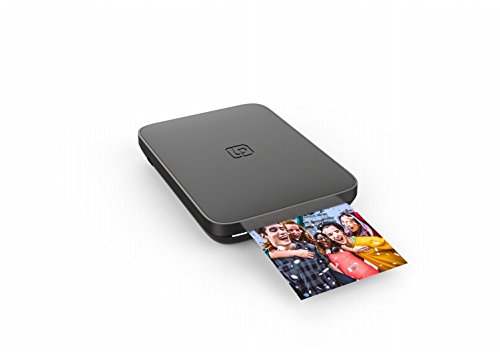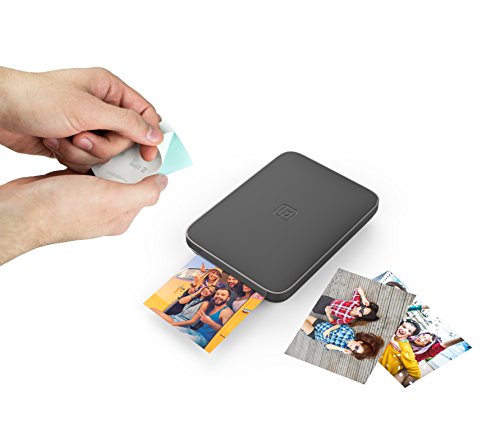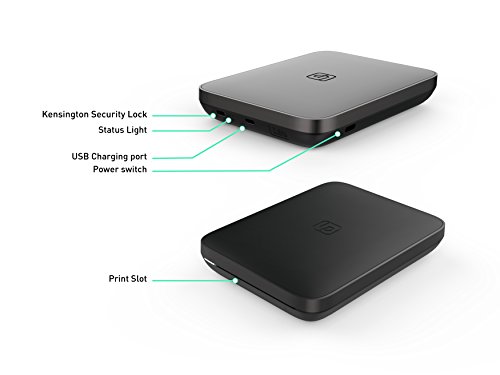تسليم إلى EGYPT
Iللحصول على أفضل تجربة احصل على التطبيق
معلومات عنا
حقوق الطبع والنشر © 2024 Desertcart Holdings Limited





Size Name:3x4.5  |  Style Name:Printer  |  Colour Name:Black Product Description Welcome to an awesome invention for printing photos, videos, and GIFs that come to life before your eyes: the Lifeprint 3x4 Hyperphoto printer for iPhone. With our redesigned instant photo printer, augmented reality printing is bigger, better, and broader than before. Box Contains Lifeprint 3x4.5 Portable Photo AND Video Printer for iPhone and Android. Make Your Photos Come To Life w/ Augmented Reality - Black


D**L
Augmented Reality Photo Printer
On the face of it this is a pretty standard ZINK printer - 'ZINK' because Zero ink is needed, and therefore no printer cartridge is required - colours are activated heating the thermal paper. This is the smaller of two Lifeprint models. The larger Lifeprint Photo AND Video Printer. Augmented Reality makes your photos come to life. 3x4.5 no ink photos: White is the same in all respects apart from the fact it produces larger prints - 3 x 4.5 inches rather than the 2 x 3 inch prints that this model creates. As I've noted there are other models produced by Kodak and HP for example.The printer is tiny - no wider than an iPhone X and only about 4/5 of its height. It's over 2cm thick though. With the printer you get a USB charging cable and a pack of 10 sheets of thermal paper. The printer connects to iOS or Android phones, or tablets, via bluetooth. Charging is via the USB cable and once charged the printer is completely cable free with sufficient battery power to do around 20 prints. Print quality is fair - think of rather higher quality than an old Polaroid instant print. However, due to the nature of the ZINK process you will not get anything approaching the quality of print you'd get from a colour inkjet printer costing the same - you're paying for portability and on the go printing here. The prints are very small - just 2 inches by 3 inches for this model, so about the size of a credit card. Again this is pretty standard and has the advantage that the relatively low resolution of the image is not as apparent as it would be for larger prints.To get all this to work you have to download the Lifeprint app. You also have to provide rather a lot of personal information to use the app - name, email address, and mobile phone number. You're also encouraged to link to social media accounts such as Facebook and Twitter. You'll receive a text containing a code to enter into the app before it will work. You will also need to respond to an email to confirm your email address. Once all that's done, and you’ve also provided the app with access to your photo/video libraries, you're ready to use the printer.At this point the Lifeprint printer does not behave like a standard small photo printer and I'm surprised that other reviewers to date have not mentioned this. The key element of the printer is that it uses virtual reality technology. If you have a video, or an Apple phone which records a little video footage when taking a standard picture, the app viewer will play the video when the printed photo is viewed by the phone. This results in an experience not dissimilar to a Harry Potter hallway painting. So you might take a short video of a cat playing. You chose a frame from the video to print as a photo and once printed if you view the paper photo through the app the video will play within the frame of the printed photo you’re holding - so if you’re holding the photo with the TV in the background the TV will still be there but the paper photo will show a video instead of the static photo.This is not new technology. It's like using your phone camera to read a bar code that opens a webpage or makes a 3D VR image appear. The software is simply analysing the photo as if it were a bar code and associating that pattern with your photo.What this means is that you can give people the small photo prints - which have sticky backs so can be attached to a fridge for instance - and if they have the app they will see a video when viewing the print you've sent them with their phone. There's something of a wow factor here and it's certainly an entertaining feature.Moreover no registration is needed to view photos using the app - you just select the view hyperphoto and view the printed image through your phone. Brilliant stuff!There are some issues with this though. In order to view the video the photo and associated video has to be uploaded to a Lifeprint social media account. You have to open an account to use the printer. By default these photos are made publicly available and anyone can print them and see the associated video. To prevent this each time you choose to print an image you need to select the 'Private' option. Also, of course, you're reliant on Lifeprint's servers being available in the future. No server, no prints... The need to upload images to facilitate printing also means that to use the printer you'll need an internet connection so while you can make prints anywhere, you can only do it if your phone has a network connection.I guess if all of the VR stuff makes no sense to you, you're better off buying a standard HP or Polaroid mobile photo printer. And because the prints are so small these pictures are not the sort of thing to put in a traditional family photo album - much better to use a colour inkjet printer for that.The actual app is OK. Some features are not particularly intuitive and you need to remember to customise privacy settings each time. There's some image processing functionality to improve your photos but you're probably better using another app for that before printing the image using the Lifeprint app.Other considerations are that you have to buy Lifeprint photo paper to use with the printer. The company suggest, with some cogency, that other ZINK paper will not work well as it will not be calibrated with the thermal profile of their printers. The paper is not cheap - £20 for 30 sheets or, at better value, 110 sheets for £50.Overall this is a novel and fun piece of kit and if you're into augmented and virtual reality this product is interesting and worth the price. The privacy issues will be a concern for some. On balance, the larger printer, although less portable, and requiring more expensive paper refills, might be worth a look as the prints are more practical both in a digital and analogue world.Four stars.
S**T
It’s great
Really good paper don’t need any ink for portable photo printer because paper got ink in the paper picture turn out really good.
R**S
The printer is just alright, the app makes it better
For Christmas 2016 I bought my wife a Polaroid Zip printer, which she’s been using on a fairly regular basis since, mostly printing pictures for our young son. Comparing the Zip with this Lifeprint LP001-6 (nice naming, Lifeprint) the only conclusion you can have is that they are extremely similar. The cases are different enough, the Zip being slightly thinner than the LP001, but otherwise of similar dimensions. For both models you need to pop the back off in order to insert the paper, done by sliding the top/bottom back and then lifting it off.When loading the paper, you can’t help but notice how similar the printing hardware looks (and behaves). I gives me the sneaking suspicion that the actual printing heads might even come out of the same factory somewhere and Lifeprint, Polaroid et al simply provide the cases, and ancillaries like batteries. This feeling is further strengthened by the very similar printing results, both in terms of speed and rendition. Likewise, I’m hard pressed to see anything noticeably different when comparing the different brands of Zink paper.Where the Lifeprint loses points against the Zip is with the lid to the paper compartment. It doesn’t fit very tightly and, if knocked on the back edge in a bag, can come open on its own. The design of this lid just doesn’t seem to have been given a lot of thought. The edges are squared off and it is quite deep, which means that even holding the printer the wrong way can pop it open quite easily. I’m stumped as to why they did this.So how come the LP001-6 got such good professional reviews? Well, I think that’s down to their app, which is very complete. It has a wealth of social sharing options, online storage of photos and videos and that party trick of image recognition and Augmented Reality. It doesn’t really ‘print’ videos, of course, it just provides a fun way of triggering them. Hold a print of a video in front of the phone’s camera and it will use image recognition to trigger the playback and overlay it on the photo seen through the camera. It’s clever and very gimmicky (and doesn’t always work), but does provide entertainment for family and friends.The social element of the app is a little confusing and it is hard to be certain who can actually see your photos/videos (it appears to default to the whole world). It all needs a little polish and some better explanations about how it is doing its thing, but in the end you can probably get the settings you want. There are a wealth of editing options available, including drawing, frames, stickers and so on, with more being added through app updates. Some are, admittedly, a bit fiddly to use.I’ll warn you now, Zink prints are not great. The ‘inkless’ technology is still in its infancy and it cannot compare to even a budget home inkjet printer in terms of contrast and colour rendition. Photos come out lacking in contrast, with desaturated or even incorrect colour tones. Greens can look blue blues can looks green and skin tones are muddy. Not selling this very well, am I? Just think what Polaroid cameras used to be like back in their heyday. You could recognise a Polaroid, not just from the asymmetric white border around the edge, but from the particular colour tint they had. Think of a Link printer in those terms and you can excuse the flaws a little more. Chances are that, with time, the paper will get better and better and with a firmware update or two you might start seeing better results. Fingers crossed.As an entertainment option Zink printing isn’t cheap either. The paper is pricey given the surface area you get, so pumping out silly photos for the fun of it, which is where the LP001-6 makes sense, will hit you in the pocket quite quickly. However, the ability to hand out photos on the spot, plus the fact they’re actually stickers you can personalise things with AND can be turned into videos, does have an appeal that’s hard to dismiss. A school book that can show BFF photos that can also be secret videos - does that sound cool?When choosing between Zink printers, as I mentioned, there doesn’t appear to be a lot in it outside of the design of the case (where, for me, the LP001-6 comes last). The real difference is in the apps. The great thing about that is, since the apps are free, you can download and try them out before deciding on the printer to buy. Lifeprint have possibly the most compelling one right now, but the HP Sprocket app matches it in review scores and also hints at AR support (though I couldn’t find it, maybe it is coming soon). The Polaroid app is very poorly reviewed, and the least feature rich.
ترست بايلوت
منذ 4 أيام
منذ يومين